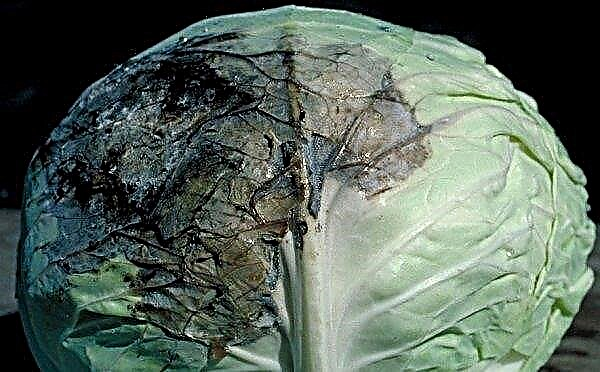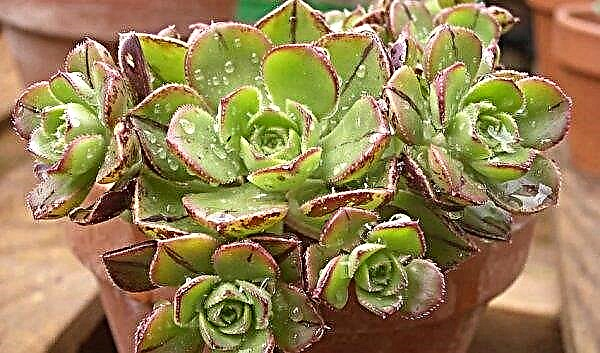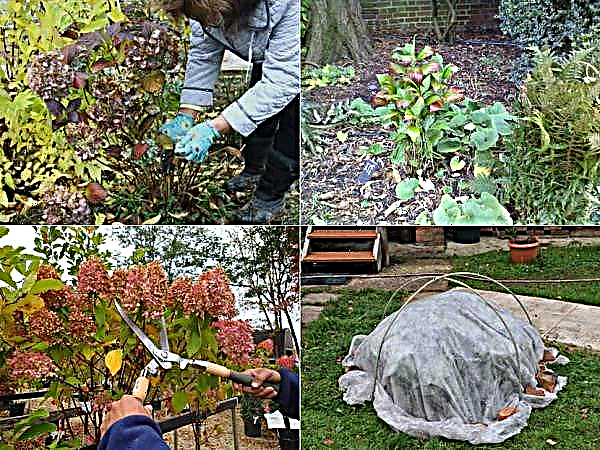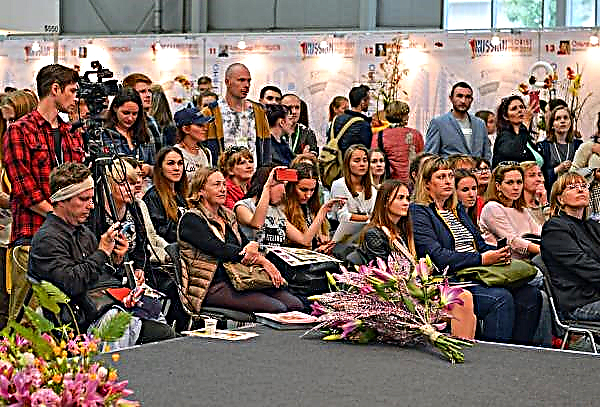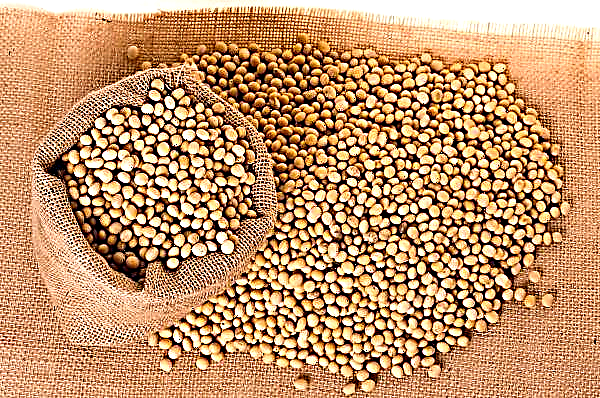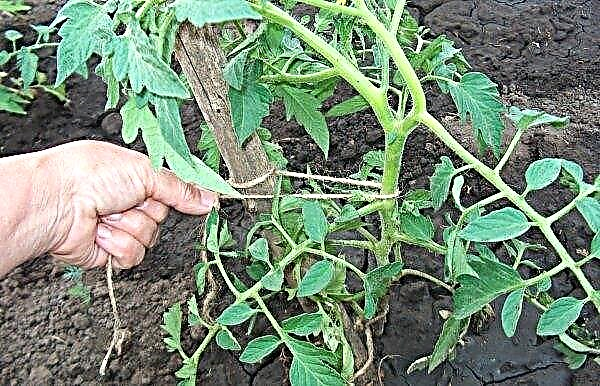For the convenience of working with bees, various protective devices and special equipment are required. Factory equipment is not difficult to assemble, but its prices are quite high, so beekeepers have adapted to use various homemade products in apiaries. About how to build a beekeeper set yourself, and will be discussed below.
Do-it-yourself protective homemade beekeeping
The main attribute of the apiary is the hive. It is easy to construct it yourself or buy in a specialized store. The situation is worse with the protective equipment of the beekeeper, who is always at risk of being bitten by bees.
Did you know? Bees are able to capture the smell of flower pollen at a distance of 1 km.
We select clothes and gloves
If the apiary is not too big, it is not necessary to buy expensive equipment - you can use the means at hand. When choosing clothes and gloves, it is better to give preference to smooth matter of a light shade. If you use equipment with fleecy structures of dark shades, there is an increased risk of not noticing insects on the clothes and suffering from their bites. In addition, it should be borne in mind that a bee is able to crawl through even the smallest hole. It is important to close the areas of the sleeves, for which they should be equipped with tightening ropes or elastic bands. The ideal option is a white jumpsuit made of dense linen fabric, equipped with elastic bands on the sleeves, legs and in the neck.
In addition, it should be borne in mind that a bee is able to crawl through even the smallest hole. It is important to close the areas of the sleeves, for which they should be equipped with tightening ropes or elastic bands. The ideal option is a white jumpsuit made of dense linen fabric, equipped with elastic bands on the sleeves, legs and in the neck.
Gloves need to be selected quite tight, but at the same time allowing free movement. The glove shaft should go under the sleeve and tightly cover the area above the wrist by 5 cm.
Making a face mask
A bee sting in the eye area is very dangerous for humans and can lead to serious vision problems, so it is important to take care to protect the front part. Such an accessory can be made from an ordinary straw hat by equipping it with a net. Small metal rings are used as fasteners, and black tulle with the smallest holes can be used as a mesh. The main thing is that a good view is opened through the holes.
In the lower part, the mesh is also equipped with small rings and a fabric strip is sewn, which will allow you to tighten the mesh around the neck.
Beekeeping Cleansing
To carry out sanitary manipulations, you will need:
- chisel;
- frequent bristle brush.
Important! As a pile for brushing, you can use the wool of livestock, for example, pigs or cows.
The first tool looks like the letter "G" in the upper working part and expanding in the lower part, like a construction spatula.
To complete the design in question, the following materials and tools will be required:
- 2 plastic or wooden linings 15 cm long and 6 cm wide;
- stainless steel plate with a width of 30 mm from one edge, 45 mm from the other and 5 cm in the central part, 55 cm long;
- 2 bolts;
- hammer;
- screwdriver.
The widest part of the plate needs to be bent in the form of the letter “G”, for which it is placed between two locking bars, leaving a protrusion of 5 cm. After fixing, the metal is given the desired shape with a hammer. Then measure 2 cm from the bend and fix the lining.
To produce a brush, you can use the long handle remaining from a broken garden tool. It is shortened to 20 cm, if necessary. Then 13 cm are measured and over the entire length of this area frequent holes are formed (not through). Preformed tufts of pile of any material are placed in these holes. It is convenient to use a radiator brush for painting as such a brush.
Useful accessories for beekeeping do-it-yourself
With a great desire, you can do almost everything yourself to serve the apiary.
- Of the main devices that facilitate the work of the beekeeper, it is worth considering the implementation of:
- a separator for frames - helps to maintain the frames in one position, leaving a certain distance between them, which reduces the risk of trauma to insects and simplifies disassembly of the structure if necessary;
- drawer stools - greatly facilitates the life of the beekeeper, being both a box for storing the necessary equipment in the apiary and a chair;
- box-type feeders - is a convenient design, divided into several parts for filling with various types of feed.
Frame divider
As dividers for frames, you can use metal stripes. Their width should correspond to the width of the bars of the frames themselves, the length can be arbitrary. To keep the frame in one position, 4 strips of metal are required. For reliable fixation, one edge of each strip must be bent: it is quite simple to do this by holding the plate between the fixing bars and giving the end the necessary shape.
Did you know? A bee is unable to sting when its belly is filled with nectar.
You can use 2 dividers per frame. In this case, the length of the plate should exceed the length of the frame by 3 cm, the width is similar to the width of the frame. When using 2 dividers, they are given a U-shape. The plates themselves are fixed, leaving 1.4 cm of length free on each side, and give them the desired shape with a hammer.
For ease of use, you can attach the dividers to the frames with screws.
Video: Frame Separator
Drawer stool
The simplest design is a regular stool with a box of a suitable size, fixed under the seat. Of the two pieces of plywood, the bottom of the box and the back wall are equipped; they are fixed with the help of corners and screws. Next, a retractable part is equipped: for this, ball guides on both sides are attached to the bottom of the bottom.
Then they select the size of the box and on the bottom of it attach the remains of the accessories. Inside the box is divided using plates of cardboard or plastic into zones of the required size for storing the tool. After complete assembly, rivets are made in the front of the drawer so that it does not fall out when carried.
Box type feeder
Such a feeder is installed in the folds for ceilings, or on the stand, in which there is an entrance for insects. The feeder is a box occupying the entire area from the front to the back wall with a height of 70 mm.
The box inside is divided using plastic partitions into 3 parts:
- a compartment for syrup;
- a feed compartment with an insect raft;
- compartment for access of bees to the box, without bottom.
The main task in this matter is to correctly arrange the partitions in the box to provide the bees with access to food. Fasten parts of the structure in any convenient way. It is best to do this with nails and seal the seams with mastic.Important! If the box is assembled from separate parts of plywood, then its smooth surface is necessarily turned to the inside.
The partition dividing the syrup compartment and the feed compartment should not reach the top by 3 mm. Fodder and letting bees' branches are separated by a partition that does not reach the top by 8 mm. In the upper part of the box, grooves for the glass cover should be equipped - this will allow you to observe the behavior of insects at the time of feeding.

When keeping an apiary, you can save a lot of money using available means to carry out its maintenance. You can use a broken tool, old boxes, boards and even pet hair.




